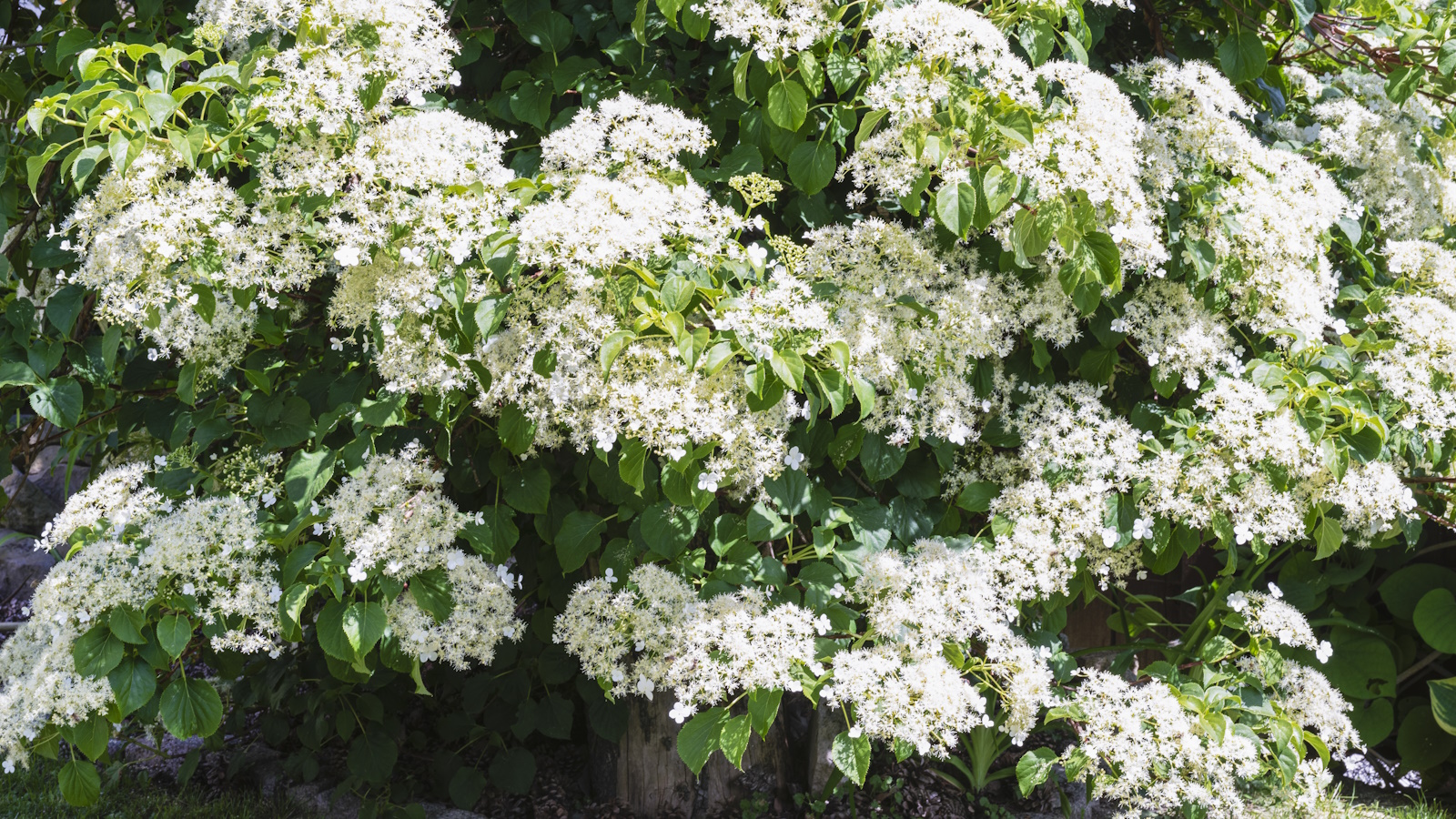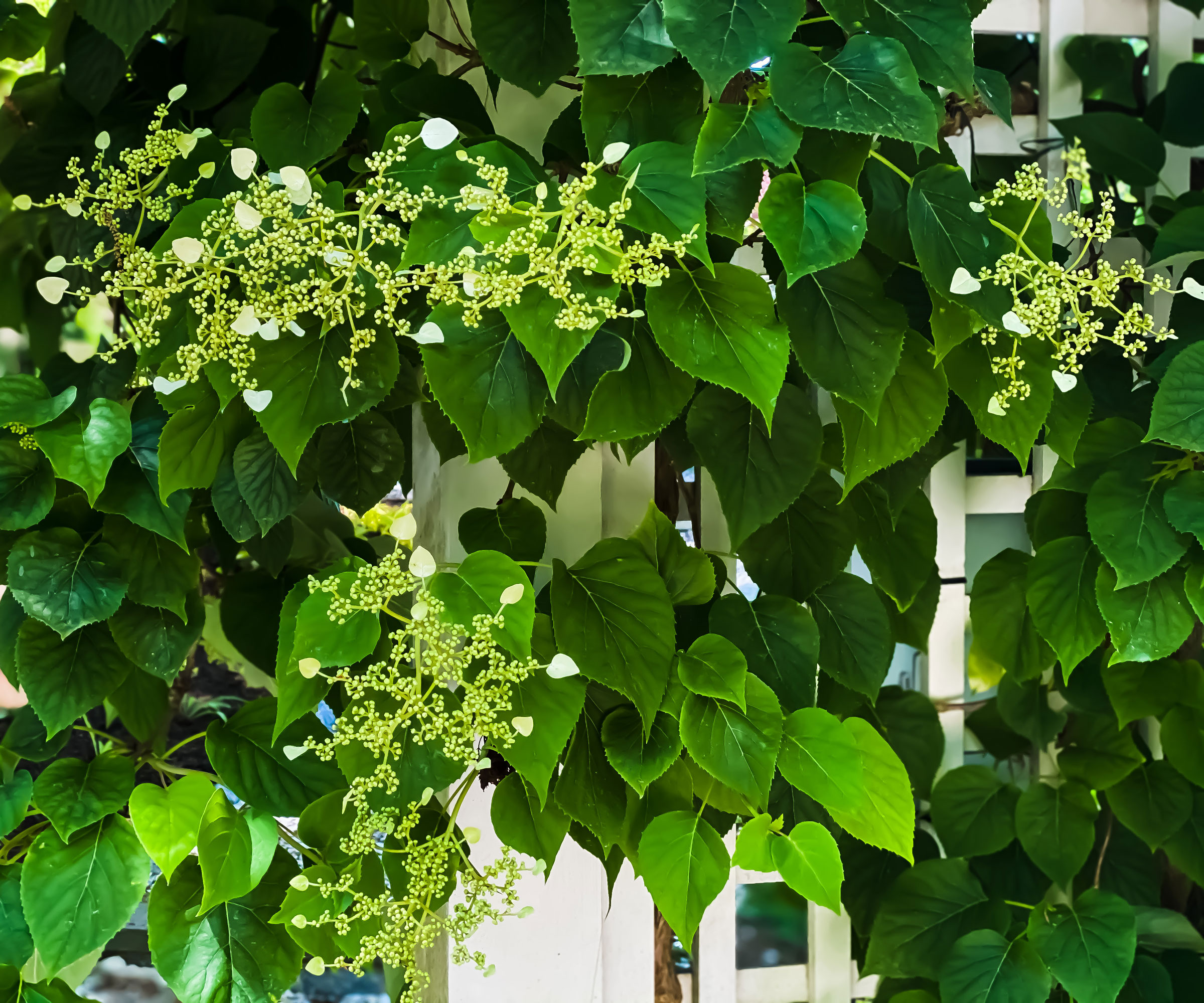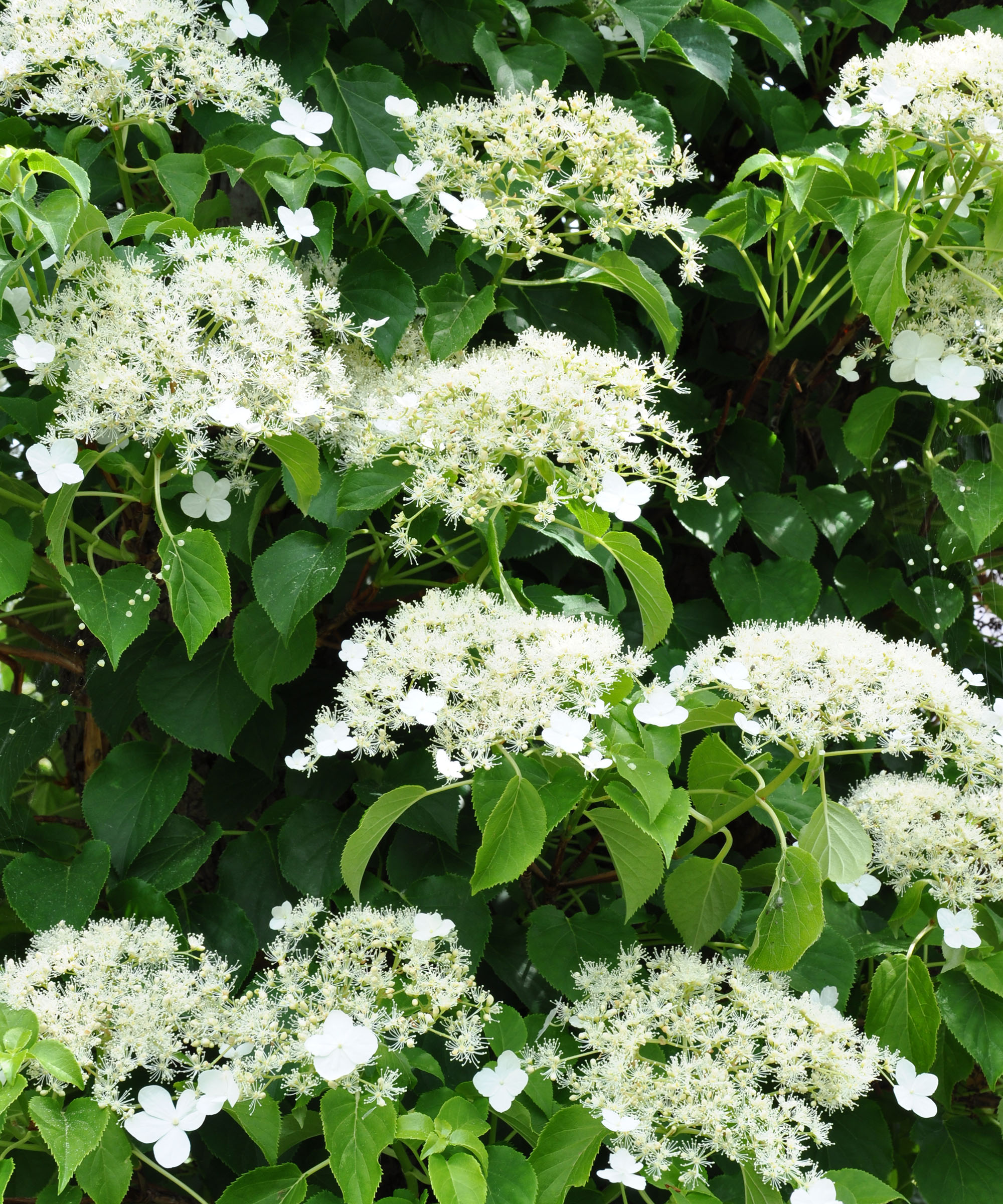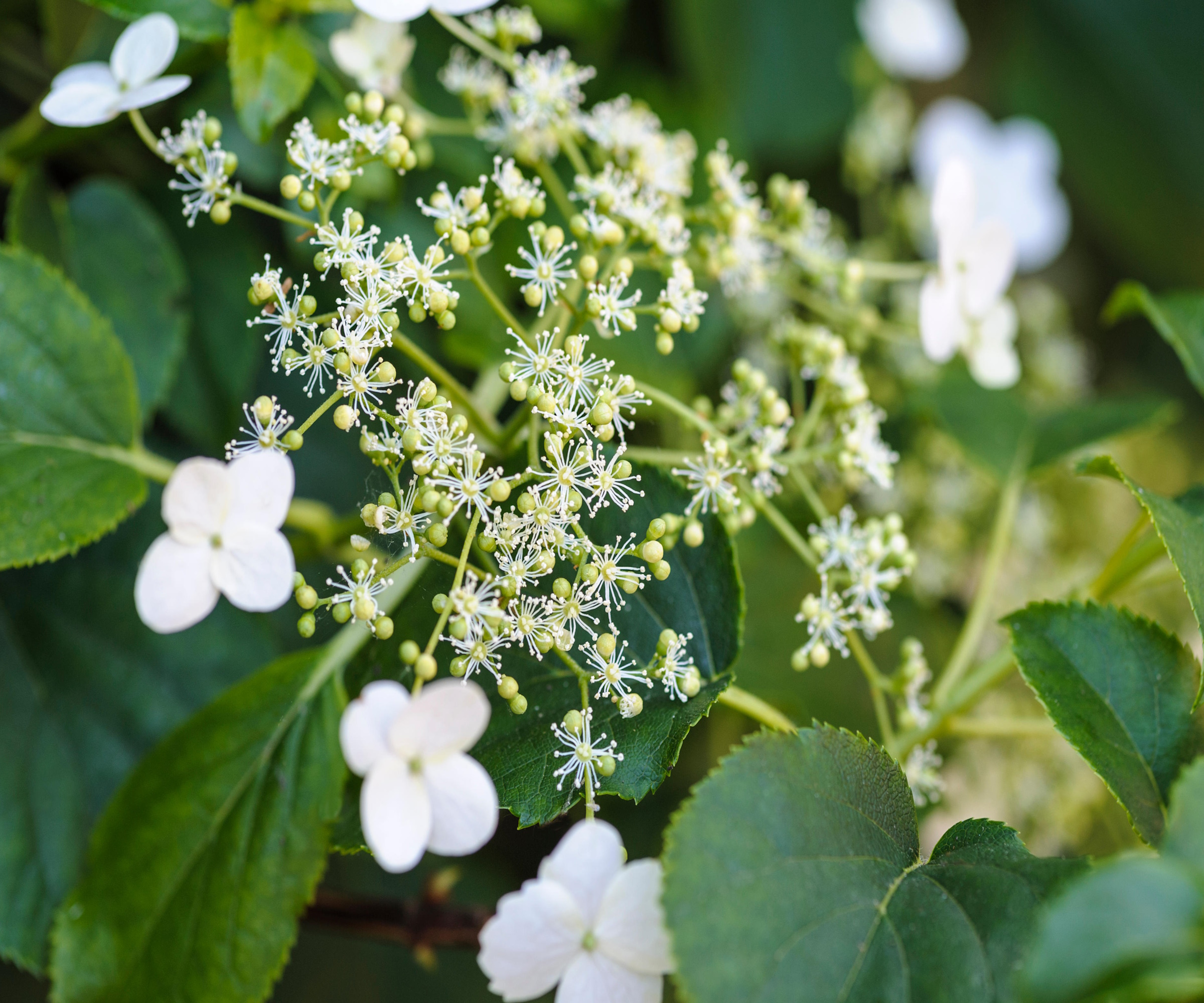
Climbing hydrangeas are beautiful vining plants that will fill vertical surfaces with lush green foliage and elegant blooms. Maximizing growing space in this way is particularly useful if you have a small yard, such as a balcony or enclosed terrace, and covering walls and fences with greenery will make the most of your outside room, whatever the size.
There are two well-known vining hydrangeas, Hydrangea anomala, also known as the Japanese climbing hydrangea, and Hydrangea petiolaris, both of which are commonly referred to as climbing hydrangeas. These plants have a similar appearance, with flat umbel-like blooms, but the Hydrangea anomala species is markedly smaller in size than Hydrangea petiolaris, which can reach up to 50 feet tall.
Climbing hydrangeas are popular plants both for their low-maintenance nature and their tolerance of shade, covering darker corners with attractive leaves and charming flowers. So, if you are considering landscaping with hydrangeas this year, our guide has all the information you need to learn how to grow elegant climbing hydrangeas.

How to grow climbing hydrangeas
While lesser known when compared with other hydrangea varieties, climbing hydrangeas are the perfect combination of beauty and utility that can brighten shady yards. This resilient climbing plant is often slow to establish, but once settled can quickly vine and fill garden walls, fences and outdoor structures.
This climbing hydrangea, Hydrangea anomala subsp. petiolaris, will produce masses of frothy white blooms that will add vertical interest in any exterior walls.
Things to know about climbing hydrangeas

Much like learning how to grow hydrangeas that are in shrub form, climbing species are similarly low-maintenance and easy to grow. Native to Asia, climbing hydrangeas are found growing in woodland areas across the Himalayas, the Korean Peninsula, and throughout China and Japan.
'Climbing hydrangeas are a popular choice among gardeners and landscape designers, appreciating the teardrop-like green leaves and flat-topped white blooms,' says Rachel Bull, head of gardens at Homes & Gardens.
'Although both the Hydrangea anomala and the Hydrangea petiolaris species are deciduous, both can create unique and intricate stem structures that look particularly good against a light stone backdrop or a wooden fence in fall and winter,' Rachel adds.
These climbing hydrangeas produce aerial roots above ground, much the same as English ivy, Hedera helix. For this reason, they do not need staking or tying in but be warned, they can damage stonework, plaster and bricks, so only plant this climber where it is free to grow without concern for damaging your home.
'Fortunately for gardeners, climbing hydrangeas are particularly tough,' Rachel continues, 'growing well from US hardiness zone 5 to US hardiness zone 8. In cooler, northern regions, it would be better to position your plant in a sunny spot, whereas in southerly, warmer areas, dappled shade is a good idea.'
Hydrangea petiolaris will quickly fill your yard with attractive, glossy, dark green foliage and creamy-white flowers in spring and summer.
Grow guide for climbing hydrangeas

- Soil: As woodland plants, climbing hydrangeas do best when grown in rich, fertile soils. They prefer slightly acidic soil, with a pH below 7. If your soil is alkaline, you can use a soil acidifier, available from Amazon, which will help keep your plant happy. I would also suggest annually mulching your borders to keep your soil in good shape and full of nutrients, using something like this organic soil, available from Walmart. While you can mulch at any time of year, I tend to do so in fall and winter when the borders are cut back and weed-free.
- Light: Climbing hydrangeas are some of the best climbing plants for shade. While they prefer dappled light with a few hours of sunshine each day, they can grow just fine in full shade. The shadier the spot, however, the fewer blooms your plant will produce. In warmer zones, such as US hardiness zone 7 plus, it is preferable to position your plant in a shady corner, to protect it during the warm summer months.
- Watering: Watering hydrangeas is crucial to their success, and much the same as other species, climbing hydrangeas prefer their soil to retain some moisture at all times. Watering at least once a week, especially during the first year, is important to help your plant establish roots.
- Fertilizing: Climbing hydrangeas do not tend to need feeding, and an annual application of mulch should provide what they need to thrive. If you are looking to maximize flower production, you can apply a fertilizer high in phosphorous during spring and summer. Use something like this bloom booster fertilizer, available from Amazon.
- Pruning: Most hydrangea pruning is carried out in late winter and early spring, however, climbing hydrangeas have a different approach. It is best to prune any dead and damaged stems in early summer after flowering. Your plant will take a while to establish, so pruning may not be necessary in the first three years. Once it is happy and settled, climbing hydrangeas may need pruning once a year to keep them compact and shapely.
Suitable for feeding any shrubs and plants in your yard, including hydrangeas, roses and peonies, helping your borders to thrive.
FAQs
Should I deadhead climbing hydrangeas once they finish flowering?
Learning how to deadhead hydrangeas is a timely task. I recommend leaving brown, faded flowerheads on your climbing plant through the winter, which will provide structure and interest in the yard. In early spring, typically late February or March, before any new growth emerges, is the best time to complete some deadheading by carefully snipping off any old blooms.
Can I change the flower color of my climbing hydrangea?
No, this is not possible. While you might have completed some research into how to change hydrangea color, this only applies to specific species, namely Hydrangea macrophylla or Hydrangea serrata, which are two common large-leaf varieties many of us grow in our yards. Climbing hydrangeas will remain a fixed color regardless of soil treatment.
If you are keen on a climbing hydrangea that is not white, Hydrangea hydrangeoides (Schizophragma hydrangeoides syn.) is a rare and unusual option.
'This is one of the easiest hydrangeas to grow,' says Lorraine Ballato, hydrangea expert and National Garden Bureau member. 'It was recently added to the Hydrangea family by taxonomists.
'People like it because of the option to have a pink flowered climber that isn't fussy about soil or light conditions,' Lorraine adds. 'It does well in shade and is very drought tolerant once established. It also does not take as long to flower as the traditional climbing hydrangea.'
Hydrangea seeds are available from Amazon.
If you fancy giving hydrangea propagation a try, why not consider growing climbing hydrangea seeds, available from Amazon? These can be sown in the fall or early spring, sowing thinly on top of a gritty soil mix. Germination will take one to two weeks, and you should keep seeds protected from the cold during the first winter.







